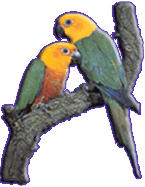|
|
| |
|
|
|
|
AFRICAN GREY PARROT
Psittacus Erythacus |
|
|
| |
|
In the wild, they can only be seen in Africa , in the western forest areas of Guinea , Sierra Leone , Ivory Coast , Congo , Ghana , Nigeria and Angola . The basic species, known under its Latin name Psittacus erithacus erithacus is a 35cm long parrot with pale grey colourings and white ends on feathers mostly expressed on the head, neck and chests. Wingspan is about 23 to 25 cm and expands to the end of the tail. Wings have dark grey colourings. The tail is short and squared, which is characteristically for most of African parrots. It reaches size of 8 to 9,5 cm and it is bright coral red. Beak is very powerful and black, while the legs are grey with black claws. Young birds are darker than adult ones, and have darker eyes, too. Around the eye, they have expressed featherless circle. Nostrils are small and they have curved head profile. The southland of Africa is mostly inhabited by the pale grey subspecies Psittacus Erythacus Principes and the north is inhabited by the subspecies Psittacus Erythacus Timneh. This subspecies has darker grey colorations, longer tail coloured in dark red-brown and it is not as common as Psittacus E. Principes.
Outside nesting season, Grey parrots live in colonies and roosts in tallest trees. Every morning they set out for long foraging trips in search of various fruits and seeds. They make nests in tree hollows measuring 40x60cm, with an entire hole of 12cm across. Females lay 2 to 4 white eggs in 3-day intervals and sit on them for 30 days. After the hatching, chicks stay in the nest for ten weeks and after the first flight they stay for three more months with their parents. In that period, young birds have pale feet and beak. These parrots cannot stand low temperatures, so the temperature must be maintained above 18*C.
|
|
|
| |
|
The Grey parrot, no matter subspecies, excels all other birds in its intellect and ability to imitate human speech, various tunes and sounds. There are no better speakers than Greys, and not only can they mimic words, they are also able to associate those words with appropriate time. For example, they will say “good night” or “good morning” in the evening or in the morning ; they will never make a mistake. When in captivity, African Grey soon and very easy forgets its loud natural calls. The fact that these parrots can learn to imitate about 8 hundred words (a bit lesser words than humans use every day); can be found in all professional ornithology books. When it comes to their intellect abilities, it is proved that Greys are on the same level as five-year-old child, and that place them in the group of the most intelligent animals on the world, beside chimps.
Single kept Grey should be housed in a large thick-wired cage with secured doors, as they can easily learn to open the cage. Once or twice a week the bird should be sprayed with tepid water or exposed to a summer rain. These birds enjoy basking in the morning and evening sun, which is also a time to “comb” their feathers. They have a long life expectancy, even up to one hundred years. Some individuals never become quite tame, although they mimic sounds, tunes and words, which show their personality. The sexes are difficult to distinguish, if there is just one bird it is impossible to know the sex because the difference can be made only by comparing. |
|
|
| |
The diet covers black-and-white sunflower in the summer or black sunflower in the winter period, oat, proso, sorghum, hemp, bright seed, hazelnuts, unpeeled peanuts, fruits and greens. Form time to time their every diet should be enriched with cooked veal as a replacement for their natural protein food. Vitamins and minerals are also required.
After all that is written on this page I believe, any further comments or compliments on these birds are redundant. You just have to make the choice, now it is up to you. |
|
|
| |
|
|
| |
| |
|
|
|
|

